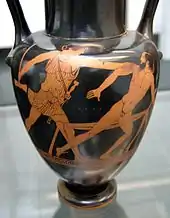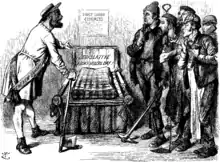Procrustes
In Greek mythology, Procrustes (/proʊˈkrʌstiːz/; Greek: Προκρούστης Prokroustes, "the stretcher [who hammers out the metal]"), also known as Prokoptas or Damastes (Δαμαστής, "subduer"), was a rogue smith and bandit from Attica who attacked people by stretching them or cutting off their legs, so as to force them to fit the size of an iron bed.

The word "Procrustean" is thus used to describe situations where an arbitrary standard is used to measure success, while completely disregarding obvious harm that results from the effort.
Mythology
In the Greek myth, Procrustes was a son of Poseidon with a stronghold on Mount Korydallos at Erineus, on the sacred way between Athens and Eleusis.[1] There he had a bed, in which he invited every passer-by to spend the night, and where he set to work on them with his smith's hammer, to stretch them to fit. In later tellings, if the guest proved too tall, Procrustes would amputate the excess length; nobody ever fitted the bed exactly.[2] Procrustes continued his reign of terror until he was captured by Theseus, travelling to Athens along the sacred way, who "fitted" Procrustes to his own bed:
He killed Damastes, surnamed Procrustes, by compelling him to make his own body fit his bed, as he had been wont to do with those of strangers. And he did this in imitation of Heracles. For that hero punished those who offered him violence in the manner in which they had plotted to serve him.[3]
Killing Procrustes was Theseus's last adventure on his journey from Troezen to Athens.
Cultural references

A Procrustean bed is an arbitrary standard to which exact conformity is forced.
- In Edgar Allan Poe's influential crime story "The Purloined Letter" (1844), the private detective Dupin uses the metaphor of a Procrustean bed to describe the Parisian police's overly rigid method of looking for clues.
- French philosopher Jacques Derrida, in "The Purveyor of Truth", his response to Jacques Lacan's seminar on "The Purloined Letter" (1956), applies the metaphor to the structural analysis of texts: "By framing in this violent way, by cutting the narrated figure itself from a fourth side in order to see only triangles, one evades perhaps a certain complication."[4] This is one of deconstruction's central critiques of structural (and formal) literary analysis. Slavoj Žižek draws upon the metaphor to critique poetic form: "The most elementary form of torturing one's language is called poetry—think of what a complex form like a sonnet does to language: it forces the free flow of speech into a Procrustean bed of fixed forms of rhythm and rhyme."[5] Poet Hollis Robbins draws upon the metaphor to structure a sonnet about cutting lines to fit meter and rhyme.[6]
- Thomas Jefferson used the Procrustean bed as a metaphor in a paper on religious freedom. "Reason and experiment have been indulged, and error has fled before them. It is error alone which needs the support of government.Truth can stand by itself. Subject opinion to coercion: whom will you make your inquisitor? Fallible men; men governed by bad passions, by private as well as public reasons. And why subjected to coercion? To produce uniformity. But is uniformativity desirable? Introduce the bed of Procrustus then, and as there is danger that the large men may beat the small, make us all of a size, by lopping the former and stretching the latter. Difference of opinion is advantageous in religion." [7]
- The concept of the Procrustean bed has been invoked by Eurosceptics to describe the relationship between the Eurozone and its member states.[8]
- Theodosius Dobzhansky, a founding figure in evolutionary biology and genetics, wrote "Progress of scientific understanding is often obstructed and side-tracked when a working hypothesis which proves serviceable in a certain field is used as a Procrustean bed to mutilate the evidence derived from other fields."[9] Dobzhansky made this chiding statement in response to claims that certain biological phenomena could only arise via one mechanism.
- The Austrian-American writer Erik von Kuehnelt-Leddihn's 1943 book The Menace of the Herd, or Procrustes at Large is a critique of what the author describes as the negative effects of egalitarianism as a political philosophy, where state power is used to force individuals to fit the standards designed by politicians and intellectuals.
- In a poem Damastes (Also Known as Procrustes) Speaks (Damastes z przydomkiem Prokustes mówi) Polish poet Zbigniew Herbert shows an analogy between 'fitting' people to the bed of Procrustes and totalitarian regimes of 20th century trying to create a 'new man' that will be subordinate to their authority.
- The Bed of Procrustes: Philosophical and Practical Aphorisms is a 2010 book by philosopher and probability theorist Nassim Nicholas Taleb, author of The Black Swan and Antifragile. Giving continuation to this idea, in Antifragile, the author uses the image of the Procrustean bed as an allegory to modernity, linking it to present-day man's fear of randomness.
- Procrustes analysis is the process of performing a shape-preserving Euclidean transformation to a set of shapes. This removes variations in translation, rotation and scaling across the dataset in order to move them into a common frame of reference. This is generally the precursor to further statistical analysis. A related problem in linear algebra is the orthogonal Procrustes problem of finding the closest orthogonal matrix to any given matrix.
- A Procrustean solution is the undesirable practice of tailoring data to fit its container or some other preconceived structure. In a Procrustean solution in statistics, instead of finding the best fit line to a scatter plot of data, one first chooses the line one wants, then selects only the data that fits it, disregarding data that does not, so to "prove" some idea. It is a form of rhetorical deception made to forward one set of interests at the expense of others. The unique goal of the Procrustean solution is not win-win, but rather that Procrustes wins and the other loses. In this case, the defeat of the opponent justifies the deceptive means.
- In computer science, a Procrustean string is a fixed length string into which strings of varying lengths are placed. If the string inserted is too short, then it is padded out, usually with spaces or null characters. If the string inserted is too long, it is truncated. The concept is mentioned in the Sinclair ZX81 and Sinclair Spectrum user manuals, where a portion of a string is replaced by another string using Procrustean assignment—the replacement string is truncated or padded in order to have length equal to the portion being replaced.[10] Although the term did not catch on in wider usage, it appears in some references, notably FOLDOC.[11]
- The film editor Walter Murch refers, not entirely negatively, to a certain style of film editing as "procrustean". If the first assembly of a film is too long by a certain amount, that amount is removed quickly, sometimes brutally. Then the film is viewed at this new length, and progress afterwards is aimed at smoothing out the amputations without adding length.[12] Similarly, Vince Gilligan alludes to the Procrustean bed when stating that each episode of Breaking Bad had to be edited to a length of exactly 47 minutes, 7 seconds, and 4 frames.[13]
- Procrustes appears in the Percy Jackson & the Olympians book The Lightning Thief. This version is depicted as a half-giant.
- In the Eastern world, the legend of Procrustes figures prominently in Malayalam literature beginning with the highly acclaimed poem titled eponymously "Procrustes" by Vayalar Ramavarma.
- Patul lui Procust (The Bed of Procrustes) a novel by Romanian author Camil Petrescu.
- Sleepless Nights in the Procrustean Bed is a collection of essays by Harlan Ellison.
- In A. F. Th. van der Heijden's novel Het Schervengericht (Jugement by shards) Procrustes' bed is used as a symbol for the strict standards of the society.
See also
- Ergonomics
- Generalized Procrustes analysis
- One size fits all
- Procrustes analysis
- Rack (torture)
- Xenia (Greek) - the Greek concept of hospitality that Procrustes was guilty of violating
Notes
- Tripp, Edward. The Meridian Handbook of Classical Mythology. Meridian, 1970, p. 498.
- This detail, which injects a note of verisimilitude, is reported by both pseudo-Apollodorus (Epitome1.4) and Hyginus. "Later it was stated, by those who did not think of the meaning of Prokrustes, Prokoptas and Damastes, that he even had two beds, a large one and a small one." (Karl Kerenyi, The Heroes of the Greeks, 1959:223, noting pseudo-ApollodorusDiodorus Siculus, 4.59.5.)
- Plutarch, Vita Thesei §11a. (Theoi.com on-line English translation).
- Derrida, Jacques, "The Purveyor of Truth", in The Purloined Poe: Lacan, Derrida, and Psychoanalytic Reading eds. John P. Muller and William J. Richardson,
- Less Than Nothing: Hegel and Shadow of Dialectical Materialism Verso 2012 p. 871
- "Acrostic" http://www.mezzocammin.com/iambic.php?vol=2011&iss=1&cat=poetry&page=robbins
- Jefferson, Thomas (1884). Notes on the State of Virginia, Writings. N.Y, N.Y.: Literary Classics of the United States. p. 286. LCCN 83-19917.
- Marine Le Pen, After Brexit the people's spring is inevitable New York Times 28 June 2016
- Dobzhansky, T. (1955). "A review of some fundamental concepts and problems of population genetics". Cold Spring Harbor Symposia on Quantitative Biology. 20: 1–15. doi:10.1101/SQB.1955.020.01.003.
- Vickers, Steven (1981). Sinclair ZX81 BASIC Programming. Sinclair Research Limited. Chapter 21.
- Howe, Denis (12 September 1997). "Procrustean string". Free On-line Dictionary of Computing. Retrieved 8 July 2020.
- "Nothing Ever Changes, or Does It?". Folkmanbrothers.com. Archived from the original on 23 January 2013. Retrieved 14 July 2014.
- Dixon, Kelley; Gilligan, Vince (24 July 2012). "Episode 502: 'Madrigal'". Breaking Bad Insider Podcast. Stitcher Radio. Retrieved 1 February 2017. Approximately 1 hour, 10 seconds in.
References
- Diodorus Siculus, The Library of History translated by Charles Henry Oldfather. Twelve volumes. Loeb Classical Library. Cambridge, Massachusetts: Harvard University Press; London: William Heinemann, Ltd. 1989. Vol. 3. Books 4.59–8. Online version at Bill Thayer's Web Site.
- Diodorus Siculus, Bibliotheca Historica. Vol. 1–2. Immanel Bekker. Ludwig Dindorf. Friedrich Vogel. in aedibus B. G. Teubneri. Leipzig. 1888–1890. Greek text available at the Perseus Digital Library.
- Gaius Julius Hyginus, Fabulae from The Myths of Hyginus translated and edited by Mary Grant. University of Kansas Publications in Humanistic Studies. Online version at the Topos Text Project.
- Lucius Mestrius Plutarchus, Lives with an English Translation by Bernadotte Perrin. Cambridge, MA. Harvard University Press. London. William Heinemann Ltd. 1914. 1. Online version at the Perseus Digital Library. Greek text available from the same website.
- Pausanias, Description of Greece with an English Translation by W. H. S. Jones, Litt.D., and H. A. Ormerod, M.A., in 4 Volumes. Cambridge, MA, Harvard University Press; London, William Heinemann Ltd. 1918. Online version at the Perseus Digital Library
- Pausanias, Graeciae Descriptio. 3 vols. Leipzig, Teubner. 1903. Greek text available at the Perseus Digital Library.
- Pseudo-Apollodorus, The Library with an English Translation by Sir James George Frazer, F.B.A., F.R.S. in 2 Volumes, Cambridge, MA, Harvard University Press; London, William Heinemann Ltd. 1921. Online version at the Perseus Digital Library. Greek text available from the same website.
- Xenophon, Memorabilia II 1.14 (4th-century BC).
- About maths and myths: A spanish article published in El País about the origin of some problems
External links
 Media related to Procrustes at Wikimedia Commons
Media related to Procrustes at Wikimedia Commons The dictionary definition of procrustean at Wiktionary
The dictionary definition of procrustean at Wiktionary